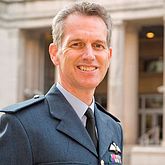Chief of the Air Staff (United Kingdom)
| Chief of the Air Staff (CAS) |
|
|---|---|

Ensign of the Royal Air Force
(CAS Command Flag) |
|
| Ministry of Defence | |
| Style | Air Chief Marshal |
| Member of |
Defence Council Air Force Board |
| Reports to | Chief of the Defence Staff |
| Nominator | Secretary of State for Defence |
| Appointer |
Prime Minister Subject to formal approval by the Queen-in-Council |
| Inaugural holder |
Major-General Sir Hugh Trenchard |
| Website | raf.mod.uk |
The Chief of the Air Staff (CAS) is the professional head of the Royal Air Force and a member of both the Chiefs of Staff Committee and the Air Force Board. The post was created in 1918 with Major-General Sir Hugh Trenchard as the first incumbent. The current and 31st Chief of the Air Staff is Air Chief Marshal Sir Stephen Hillier, who succeeded Sir Andrew Pulford in July 2016.
The post was established in January 1918, just prior to the official formation of the RAF, and its first occupant was Major-General Sir Hugh Trenchard. Following Trenchard's resignation in March 1918 after disagreements with the first air minister, his rival Major-General Sir Frederick Sykes was appointed. For political reasons Trenchard's resignation did not take effect until late April in order that he would be CAS when the RAF was formed. With Churchill's post-War appointment as Secretary of State for War and Air, Sykes was moved sideways to head up the nascent Civil Aviation ministry and Trenchard returned as Chief of the Air Staff. In the early 1920s Trenchard had to fight to keep the RAF from being divided and being absorbed back into the Royal Navy and the British Army. After Lord Trenchard retired in 1930 there were still suggestions that the RAF should be broken up, but Trenchard's foundations proved solid.
By the time World War II broke out in 1939, the then occupant of the post, Air Chief Marshal Sir Cyril Newall, had a service that had been undergoing the most rapid of expansions during the British rearmament programs of the late 1930s. Newall gave way in 1940 to Air Chief Marshal Sir Charles Portal, who led the service for the rest of the war. Portal was a tireless defender of the RAF and extremely able in administration and strategy. Postwar the RAF was reoriented to perform the dual roles of defending the shrinking British Empire and possibly fighting against the Soviet Union in a Warsaw Pact verses NATO war over Germany and the United Kingdom. The Chiefs of the Air Staff of the day had to fight a constant battle to keep the British aircraft industry alive. In the end only minimal success was achieved, with only a rump aviation industrial base left by the 1970s.
...
Wikipedia

